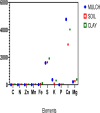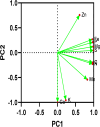Effects of food waste mulch on the physicochemical quality and fungal community diversities of desert soil in Southeast Iran
- PMID: 39565811
- PMCID: PMC11578483
- DOI: 10.1371/journal.pone.0310518
Effects of food waste mulch on the physicochemical quality and fungal community diversities of desert soil in Southeast Iran
Abstract
In semi-arid and arid regions, mulching with various materials is one of the highly significant ways to keep soil surface coverage. This approach helps efficiently reduce drought stress and soil erosion, thus preserving soil composition and ecosystem. The research aimed to pinpoint the physicochemical alterations and fungal diversity brought on by food waste mulch (FWM) in the desert soil. An experimental field assessment was conducted from early April (spring) to late August (summer) 2021 in the soil of the Jupar desert, the main watershed of the Central Plateau, southeastern Iran. The mulch was made from a combination of clay (70%), food waste (15%), and water and sprayed in 3 plots on the Jupar desert soil surface as a case group. Moreover, 3 plots of the Jupar desert soil and clay were selected as a non-mulch-controlled surface (control groups). The physicochemical changes were studied in all groups including FWM, desert soil, and clay. Besides, the samples were cultured and checked daily to determine the growth of fungal colonies. All fungal isolates were characterized to the species level by phenotypical and molecular methods. Sequence analysis of the ITS1, 5.8S, and ITS2 regions was done. The statistical findings displayed that the physical and chemical characteristics of FWM (case group) were significantly different compared to clay and soil samples (control groups) (P<0.05). Phenotypic and genotypic analysis of the fungal consortium showed that the most frequent filamentous and yeast fungi belonged to the Alternaria and Naganishia genera, respectively. Identified fungi are classified as growth-inducing and anti-pest fungi. This study showed that adding FWM of organic matter can cause partial variety in soil fungal diversity and stabilize the desert soil due to enriching the organic matter in eroding soils.
Copyright: © 2024 Hajhosseini et al. This is an open access article distributed under the terms of the Creative Commons Attribution License, which permits unrestricted use, distribution, and reproduction in any medium, provided the original author and source are credited.
Conflict of interest statement
The authors have declared that no competing interests exist.
Figures







Similar articles
-
Temporal and Habitat Dynamics of Soil Fungal Diversity in Gravel-Sand Mulching Watermelon Fields in the Semi-Arid Loess Plateau of China.Microbiol Spectr. 2023 Jun 15;11(3):e0315022. doi: 10.1128/spectrum.03150-22. Epub 2023 May 4. Microbiol Spectr. 2023. PMID: 37139552 Free PMC article.
-
Organic mulching positively regulates the soil microbial communities and ecosystem functions in tea plantation.BMC Microbiol. 2020 Apr 29;20(1):103. doi: 10.1186/s12866-020-01794-8. BMC Microbiol. 2020. PMID: 32349665 Free PMC article.
-
Spatial Patterns of Soil Fungal Communities Are Driven by Dissolved Organic Matter (DOM) Quality in Semi-Arid Regions.Microb Ecol. 2021 Jul;82(1):202-214. doi: 10.1007/s00248-020-01509-6. Epub 2020 Apr 22. Microb Ecol. 2021. PMID: 32322922
-
Fungal diversity in the Atacama Desert.Antonie Van Leeuwenhoek. 2018 Aug;111(8):1345-1360. doi: 10.1007/s10482-018-1060-6. Epub 2018 Mar 7. Antonie Van Leeuwenhoek. 2018. PMID: 29516313 Review.
-
Trends in Antarctic soil fungal research in the context of environmental changes.Braz J Microbiol. 2024 Jun;55(2):1625-1634. doi: 10.1007/s42770-024-01333-x. Epub 2024 Apr 23. Braz J Microbiol. 2024. PMID: 38652442 Free PMC article. Review.
References
-
- Bolca M, Turkyilmaz B, Kurucu Y, Altinbas U, Esetlili MT, Gulgun B. Determination of impact of urbanization on agricultural land and wetland land use in Balçovas’ Delta by remote sensing and GIS technique. Environmental monitoring and assessment. 2007;131:409–19. - PubMed
-
- Huang J, Yu H, Guan X, Wang G, Guo R. Accelerated dryland expansion under climate change. Nature climate change. 2016;6(2):166–71.
-
- Fiore M, Chiara F, Adamashvili N. Food Loss and Waste, a global responsibility?! Food Loss and Waste, a global responsibility?! 2019:825–46.
-
- L X-Y. Gravel–sand mulch for soil and water conservation in the semiarid loess region of northwest China. Catena. 2003;52(2):105–27.
MeSH terms
Substances
LinkOut - more resources
Full Text Sources
Medical
Miscellaneous

